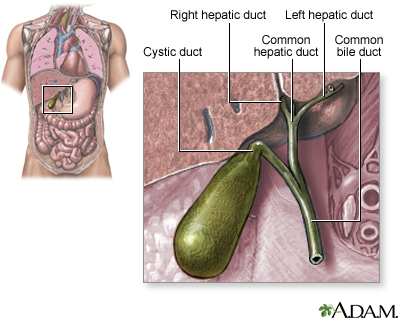Health Library
Gallbladder removal - laparoscopic - discharge
Cholecystectomy laparoscopic - discharge; Cholelithiasis - laparoscopic discharge; Biliary calculus - laparoscopic discharge; Gallstones - laparoscopic discharge; Cholecystitis - laparoscopic discharge
Laparoscopic gallbladder removal is surgery to remove the gallbladder using a medical device called a laparoscope.
Images


Presentation

I Would Like to Learn About:
When You're in the Hospital
You had a procedure called a laparoscopic cholecystectomy. Your doctor made 1 to 4 small cuts in your belly and used a special instrument called a laparoscope to take out your gallbladder.
What to Expect at Home
Recovering from laparoscopic cholecystectomy will take up to 6 weeks for most people. You may be back to most normal activities in a week or two, but it can take several weeks to return to your normal energy level. You may have some of these symptoms as you recover:
- Pain in your belly. You may also feel pain in one or both shoulders. This pain comes from the gas still left in your belly after the surgery. The pain should ease over several days to a week.
- A sore throat from the breathing tube. Throat lozenges may be soothing.
- Nausea and maybe throwing up (vomiting). Your surgeon can provide you with nausea medicine if needed.
- Loose stools after eating. This may last 4 to 8 weeks. However, in some cases it can last longer.
- Bruising around your wounds. This will go away on its own.
- Skin redness around your wounds. This is normal if it is just around the incision.
Activity
Start walking after surgery. Begin your everyday activities as soon as you feel up to it. Move around the house and shower, and use the stairs during your first week home. If it hurts when you do something, stop doing that activity.
You may be able to drive after a week or so if you are not taking strong pain medicines (narcotics) and if you can move quickly without being hampered by pain if you need to react in an emergency. Don't do any strenuous activity or lift anything heavy for at least a couple of weeks. At any time, if any activity causes pain or pulls on the incisions, just don't do it.
You may be able to go back to a desk job after a week depending upon how much pain you are having and how energetic you feel. Talk to your health care provider if your work is physical.
Wound Care
If sutures, staples, or glue were used to close your skin, you may take off the wound dressings and take a shower the day after surgery.
If tape strips (Steri-strips) were used to close your skin, cover the wounds with plastic wrap before showering for the first week after surgery. Do not try to wash the Steri-strips off. Let them fall off on their own.
Do not soak in a bathtub or hot tub, or go swimming, until your doctor tells you it is OK.
Diet
Eat a high-fiber diet. Drink 8 to 10 glasses of water every day to help ease bowel movements. You may want to avoid greasy or spicy foods for a while.
Follow-up
Go for a follow-up visit with your provider 1 to 2 weeks after your surgery.
When to Call the Doctor
Contact your provider if:
- Your temperature is above 101°F (38.3°C).
- Your surgical wounds are bleeding, red or warm to the touch or you have a thick, yellow or green drainage.
- You have pain that is not helped with your pain medicines.
- It is hard to breathe.
- You have a cough that does not go away.
- You cannot drink or eat.
- Your skin or the white part of your eyes turns yellow.
- Your stools are a gray color.
Related Information
Chronic cholecystitisAcute cholecystitis
Gallstones
References
American College of Surgeons. Cholecystectomy: surgical removal of the gallbladder. American College of Surgeons Operation Brochures for Patients. www.facs.org/media/sskdidat/cholecys.pdf. Updated 2022. Accessed November 30, 2022.
Brenner P, Kautz DD. Postoperative care of patients undergoing same-day laparoscopic cholecystectomy. AORN J. 2015;102(1):16-29. PMID: 26119606 pubmed.ncbi.nlm.nih.gov/26119606/.
Quick CRG, Biers SM, Arulampalam THA. Gallstone diseases and related disorders. In: Quick CRG, Biers SM, Arulampalam THA, eds. Essential Surgery Problems, Diagnosis and Management. 6th ed. Philadelphia, PA: Elsevier; 2020:chap 20.
Radkani P, Hawksworth J, Fishbein T. Biliary system. In: Townsend CM Jr, Beauchamp RD, Evers BM, Mattox KL, eds. Sabiston Textbook of Surgery. 21st ed. Philadelphia, PA: Elsevier; 2022:chap 55.
BACK TO TOPReview Date: 8/22/2022
Reviewed By: Debra G. Wechter, MD, FACS, General Surgery Practice Specializing in Breast Cancer, Virginia Mason Medical Center, Seattle, WA. Also reviewed by David C. Dugdale, MD, Medical Director, Brenda Conaway, Editorial Director, and the A.D.A.M. Editorial team.
 | A.D.A.M., Inc. is accredited by URAC, for Health Content Provider (www.urac.org). URAC's accreditation program is an independent audit to verify that A.D.A.M. follows rigorous standards of quality and accountability. A.D.A.M. is among the first to achieve this important distinction for online health information and services. Learn more about A.D.A.M.'s editorial policy, editorial process and privacy policy. A.D.A.M. is also a founding member of Hi-Ethics. This site complies with the HONcode standard for trustworthy health information: verify here. |
The information provided herein should not be used during any medical emergency or for the diagnosis or treatment of any medical condition. A licensed medical professional should be consulted for diagnosis and treatment of any and all medical conditions. Links to other sites are provided for information only -- they do not constitute endorsements of those other sites. No warranty of any kind, either expressed or implied, is made as to the accuracy, reliability, timeliness, or correctness of any translations made by a third-party service of the information provided herein into any other language. © 1997- 2024 A.D.A.M., a business unit of Ebix, Inc. Any duplication or distribution of the information contained herein is strictly prohibited.
